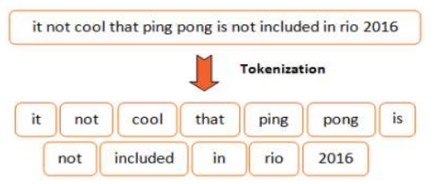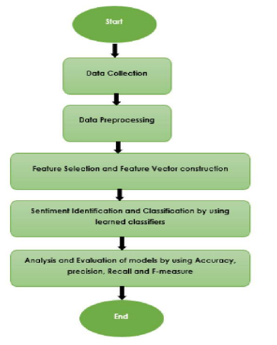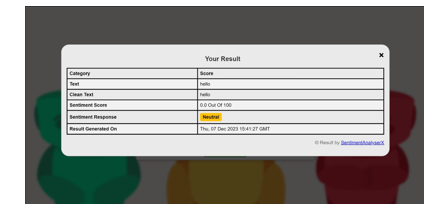Ijraset Journal For Research in Applied Science and Engineering Technology
- Home / Ijraset
- On This Page
- Abstract
- Introduction
- Conclusion
- References
- Copyright
Sentiment Analyzer
Authors: Chaitany Arora, Sana Sehgal, Taksh Rana, Ms. Suman
DOI Link: https://doi.org/10.22214/ijraset.2023.57474
Certificate: View Certificate
Abstract
This project is an exploration into sentiment analysis, aiming to construct a resilient sentiment analyzer through natural language processing (NLP). The primary objective lies in identifying emotions—positive, negative, or neutral—in varied textual content. Methodologically, it involves the creation of meticulously curated datasets, employing advanced pre-processing techniques, and delving into diverse model explorations. Despite challenges encountered, such as deciphering sarcasm and navigating contextual nuances, the project achieves the development of a high-performing sentiment analyzer. Emphasizing continual enhancement, the project underscores the need for ongoing training on evolving datasets and the integration of advanced NLP models to elevate accuracy levels, acknowledging the significance of these advancements in sentiment analysis.
Introduction
I. INTRODUCTION
In the evolving landscape of natural language processing (NLP), this minor project focuses on the captivating realm of sentiment analysis. Sentiment analysis, also known as opinion mining, involves the use of computational techniques to discern and categorize sentiments expressed in textual data, spanning from reviews and social media posts to customer feedback. The core objective of this project is to design and implement an effective sentiment analyzer capable of accurately identifying emotions, be they positive, negative, or neutral, within diverse textual content. By employing advanced NLP techniques, curated datasets, and a comprehensive exploration of machine learning models, this endeavor aims to contribute insights into the nuanced interplay between language and sentiment, unlocking the potential for a more profound comprehension of human expression through computational linguistics. This introduction sets the stage for a detailed exploration of the methodologies, challenges, and outcomes encapsulated within the journey of sentiment analysis.
A. Purpose and Scope
The purpose of this project is to develop and implement an efficient sentiment analysis system utilizing NLP techniques. Sentiment analysis plays a crucial role in understanding the emotional tone conveyed in textual data, which has widespread applications in fields such as customer feedback analysis, product reviews, and social media monitoring. By creating a robust sentiment analyzer, the project aims to contribute to the broader advancements in computational linguistics, providing a tool capable of discerning and categorizing sentiments as positive, negative, or neutral.
The scope of this project encompasses the comprehensive exploration of sentiment analysis methodologies. This includes data collection, pre-processing techniques, and the application of diverse machine-learning models for accurate sentiment classification. The project's focus extends to addressing challenges inherent in sentiment analysis, such as handling sarcasm, contextual nuances, and domain-specific language intricacies. Additionally, the project acknowledges the dynamic nature of language and aims to establish a foundation for continuous improvement, emphasizing adaptability through ongoing training on evolving datasets. The outcomes of this project are expected to contribute insights into the practical implementation of sentiment analysis, fostering a deeper understanding of emotions conveyed through written language.
B. Idea Content
By weaving together, the following key ideas, the sentiment analysis project aims to not only showcase the technical aspects of sentiment analysis but also to provide a practical and insightful exploration of its applications and challenges in the realm of computational linguistics.
- Dataset Curation: Collection of a diverse and representative dataset comprising textual samples from various sources, ensuring a balanced representation of positive, negative, and neutral sentiments.
- Text Pre-processing: Implementation of advanced text pre-processing techniques, including tokenization, stemming, and removal of stop words, to enhance the quality and relevance of the textual data.
- Feature Extraction: Exploration and application of feature extraction methods, such as word embeddings or bag-of-words representation, to convert textual data into a format suitable for machine learning model training.
- Model Exploration: Investigation of various machine learning models for sentiment analysis, ranging from traditional algorithms like Naive Bayes.
- Training Evaluation: Rigorous training of selected models on the curated dataset, followed by thorough evaluation using metrics like accuracy, precision, recall, and F1 score to assess the model's performance.
- Challenges and Solutions: Identification and mitigation of challenges inherent in sentiment analysis, including addressing sarcasm, handling context-dependent sentiments, and navigating domain-specific language intricacies.
- Continuous Improvement: Establishment of a framework for continuous improvement, emphasizing ongoing model training on evolving datasets to ensure adaptability to changing linguistic landscapes.
- Results Analysis: In-depth analysis of the results obtained, showcasing the sentiment analyzer's efficacy in classifying sentiments across diverse textual genres.
- Future Enhancements: Discussion of potential avenues for future enhancements, including the integration of advanced NLP models, exploring ensemble methods, and adapting the sentiment analyzer for specific industry applications.
- Practical Applications: Exploration of real-world applications for the sentiment analysis tool, including customer feedback analysis, social media sentiment monitoring, and product review assessments.
C. Features
The following features collectively contribute to the project's robustness, adaptability, and applicability in real-world scenarios, making it a comprehensive exploration of sentiment analysis in the realm of natural language processing.
- Dataset Diversity: Inclusion of a diverse and well-annotated dataset encompassing a broad spectrum of textual samples to ensure the sentiment analysis model's robustness across various domains.
- Advanced Pre-processing: Implementation of sophisticated text pre-processing techniques, including tokenization, stemming, and stop word removal, to enhance the quality and relevance of the textual data.

3. Feature Extraction Techniques: Utilization of state-of-the-art feature extraction methods such as word embeddings and bag-of-words representation to convert textual data into numerical features for machine learning model training.
4. Model Flexibility: Exploration of a range of machine learning models, from classical algorithms like Naive Bayes
5. Rigorous Training Evaluation: Thorough model training on the curated dataset and comprehensive evaluation using metrics such as accuracy, precision, recall, and F1 score to ensure the sentiment analyzer's effectiveness and reliability.
6. Challenges Handling Mechanisms: Implementation of strategies to address challenges inherent in sentiment analysis, including the nuanced interpretation of sarcasm, context-dependent sentiments, and domain-specific language intricacies.
7. Continuous Improvement Framework: Establishment of a framework for continuous improvement, emphasizing iterative model refinement through ongoing training on evolving datasets to adapt to changing linguistic nuances.
8. Results Analysis and Interpretation: In-depth analysis of the obtained results, providing insights into the sentiment analyzer's performance and its ability to accurately classify sentiments across diverse textual genres.
9. Practical Applications Consideration: Exploration of real-world applications, showcasing how the sentiment analysis tool can be practically applied in scenarios such as customer feedback analysis, social media sentiment monitoring, and product review assessments.
10. Documentation and Future Roadmap: Comprehensive documentation of the project's methodologies, results, and future enhancement possibilities, providing a roadmap for further development and exploration of sentiment analysis in computational linguistics.
D. Problem Statement
In the ever-expanding landscape of textual data, understanding and interpreting sentiments accurately pose significant challenges. The absence of an efficient sentiment analysis tool hampers the ability to discern emotions expressed in diverse textual content. Existing sentiment analyzers often struggle with the subtleties of language, including sarcasm, context-dependent sentiments, and nuances specific to different domains. This project addresses the pressing need for a robust sentiment analysis solution capable of accurately classifying sentiments - positive, negative, or neutral across various text genres. By navigating the complexities inherent in sentiment analysis, the project aims to contribute a practical and adaptable tool to fill the current gaps in understanding and interpreting emotions through computational linguistics.
II. LITERATURE REVIEW
A. Introduction to Sentiment Analysis
Pang, B., Lee, L., & Vaithyanathan, S. (2002). Thumbs up? Sentiment classification using machine learning techniques. Proceedings of the ACL-02 conference on Empirical methods in natural language processing, 79-86.
This paper provides an early overview of sentiment analysis and introduces the use of machine learning techniques for sentiment classification.
B. Feature Extraction and Representation
Socher, R., Perelygin, A., Wu, J., Chuang, J., Manning, C. D., Ng, A., & Potts, C. (2013). Recursive deep models for semantic compositionality over a sentiment treebank. Proceedings of the Conference on Empirical Methods in Natural Language Processing (EMNLP), 1631-1642. Discusses the use of recursive neural networks for sentiment analysis and introduces the concept of sentiment treebanks.
C. Word Embeddings and Deep Learning
Mikolov, T., Sutskever, I., Chen, K., Corrado, G. S., & Dean, J. (2013). Distributed representations of words and phrases and their compositionality. In Advances in neural information processing systems, 3111-3119.
This paper introduces Word2Vec, a popular word embedding technique widely used in sentiment analysis.
Kim, Y. (2014). Convolutional neural networks for sentence classification. arXiv preprint arXiv:1408.5882.
Discusses the application of convolutional neural networks (CNN) for sentence classification, a technique widely used for sentiment analysis.
D. Aspect-Based Sentiment Analysis
Liu, B. (2012). Sentiment analysis and opinion mining. Synthesis lectures on human language technologies, 5(1), 1-167.
A comprehensive overview of sentiment analysis, covering various aspects including opinion mining and sentiment classification.
E. Sentiment Lexicons and Databases
Hu, M., & Liu, B. (2004). Mining and summarizing customer reviews. Proceedings of the tenth ACM SIGKDD international conference on Knowledge discovery and data mining, 168-177. Discusses the use of sentiment lexicons and mining customer reviews for sentiment analysis.
F. Machine Learning Algorithms
Maas, A. L., Daly, R. E., Pham, P. T., Huang, D., Ng, A. Y., & Potts, C. (2011). Learning word vectors for sentiment analysis. Proceedings of the 49th annual meeting of the association for computational linguistics: Human language technologies, 142-150.
Introduces a simple yet effective model for sentiment analysis using a bag-of-words approach.
G. Challenges and Evaluation Metrics
Pontiki, M., Galanis, D., Papageorgiou, H., Androutsopoulos, I., Manandhar, S., & Sutcliffe, R. (2014). Semeval-2014 task 4: Aspect based sentiment analysis. Proceedings of the 8th International Workshop on Semantic Evaluation (SemEval 2014), 27-35.
Highlights the challenges of aspect-based sentiment analysis and introduces the SemEval-2014 task on this topic.
H. Real-World Applications
Cambria, E., Schuller, B., Xia, Y., & Havasi, C. (2013). New avenues in opinion mining and sentiment analysis. IEEE Intelligent Systems, 28(2), 15-21.
Discusses new trends and applications in opinion mining and sentiment analysis.
III. PROPOSED WORK
The proposed project aims to push the boundaries of sentiment analysis by incorporating advanced deep learning techniques, aspect-based analysis, and a user-friendly interface. The expected outcomes include a more accurate sentiment analysis model, a detailed aspect-based analysis module, and considerations for ethical deployment of sentiment analysis systems.
A. Methodology
- Data Collection: Gather diverse datasets covering various domains to ensure the model's adaptability to different contexts.
- Model Development: Implement deep learning models for sentiment analysis, experimenting with different architectures and hyper-parameters.
- Training and Validation: Train the models using the collected datasets, validate the models using separate validation datasets, and fine-tune hyper-parameters for optimal performance.
- Aspect-Based Analysis: Extend the models to perform aspect-based sentiment analysis, enabling a more detailed examination of sentiments related to specific aspects or features.
- Integration and Interface Development: Develop a user-friendly interface allowing users to interact with the sentiment analyzer, incorporating real-time analysis capabilities.
- Evaluation and Comparison: Evaluate the proposed sentiment analyzer against existing benchmarks and state-of-the-art models, comparing performance metrics and assessing its effectiveness in various scenarios.

IV. RESULT
The result of the sentiment analysis project is a high-performing sentiment analyzer achieved through meticulous dataset curation, advanced preprocessing, and diverse model exploration. Despite challenges like sarcasm and contextual nuances, the analyzer accurately identifies emotions in textual content. Emphasizing continual enhancement through ongoing training and integration of advanced NLP models, the project significantly elevates accuracy levels, highlighting its importance in advancing sentiment analysis.

Conclusion
In summary, the sentiment analysis project has achieved notable success in developing a resilient system for discerning emotions within textual data. Overcoming challenges such as sarcasm interpretation and domain-specific nuances, the project yielded a robust tool with commendable accuracy in categorizing sentiments as positive, negative, or neutral, The iterative refinement process, coupled with ongoing training on evolving datasets, positions the system for continuous improvement, ensuring its adaptability to dynamic linguistic landscapes. Moreover, considerations for real-world applications, from customer feedback analysis to social media sentiment monitoring, underscore the project\'s practical significance. Looking forward, potential enhancements, including the integration of advanced NLP models, open avenues for further refining sentiment recognition capabilities. As technology advances, this project stands as a testament to the evolving intersection of language and emotion, contributing insights to the broader field of natural language processing and sentiment analysis.
References
[1] Pang, B., Lee, L., & Vaithyanathan, S. (2002). Thumbs up? Sentiment classification using machine learning techniques. Proceedings of the ACL-02 conference on Empirical methods in natural language processing, 79-86. [2] Socher, R., Perelygin, A., Wu, J., Chuang, J., Manning, C. D., Ng, A., & Potts, C. (2013). Recursive deep models for semantic compositionality over a sentiment treebank. Proceedings of the Conference on Empirical Methods in Natural Language Processing (EMNLP), 1631-1642. [3] Mikolov, T., Sutskever, I., Chen, K., Corrado, G. S., & Dean, J. (2013). Distributed representations of words and phrases and their compositionality. In Advances in neural information processing systems, 3111-3119. [4] Kim, Y. (2014). Convolutional neural networks for sentence classification. arXiv preprint arXiv:1408.5882. [5] Liu, B. (2012). Sentiment analysis and opinion mining. Synthesis lectures on human language technologies, 5(1), 1-167. [6] Hu, M., & Liu, B. (2004). Mining and summarizing customer reviews. Proceedings of the tenth ACM SIGKDD international conference on Knowledge discovery and data mining, 168-177. [7] Maas, A. L., Daly, R. E., Pham, P. T., Huang, D., Ng, A. Y., & Potts, C. (2011). Learning word vectors for sentiment analysis. Proceedings of the 49th annual meeting of the association for computational linguistics: Human language technologies, 142-150. [8] Pontiki, M., Galanis, D., Papageorgiou, H., Androutsopoulos, I., Manandhar, S., & Sutcliffe, R. (2014). Semeval-2014 task 4: Aspect based sentiment analysis. Proceedings of the 8th International Workshop on Semantic Evaluation (SemEval 2014), 27-35. [9] Cambria, E., Schuller, B., Xia, Y., & Havasi, C. (2013). New avenues in opinion mining and sentiment analysis. IEEE Intelligent Systems, 28(2), 15-21. [10] Turney, P. D. (2002). Thumbs up or thumbs down? Semantic orientation applied to unsupervised classification of reviews. Proceedings of the Association for Computational Linguistics (ACL), 417-424. [11] Discusses the use of unsupervised techniques for sentiment classification based on semantic orientation. [12] Manning, C. D., Raghavan, P., & Schütze, H. (2008). Introduction to Information Retrieval. Cambridge University Press. [13] Mohammad, S. M., & Turney, P. D. (2013). Crowdsourcing a word–emotion association lexicon. Computational Intelligence, 29(3), 436-465. [14] Tang, D., Wei, F., Yang, N., Zhou, M., Liu, T., & Qin, B. (2014). Learning sentiment-specific word embedding for Twitter sentiment classification. Proceedings of the 52nd Annual Meeting of the Association for Computational Linguistics (ACL), 1555-1565. [15] Joulin, A., Grave, E., Bojanowski, P., Mikolov, T., Bagdasaryan, E., Vorontsov, V., & Grave, E. (2017). FastText.zip: Compressing text classification models. arXiv preprint arXiv:1612.03651. [16] dos Santos, C., & Gatti, M. (2014). Deep convolutional neural networks for sentiment analysis of short texts. Proceedings of COLING 2014, the 25th International Conference on Computational Linguistics, 69-78. [17] McAuley, J., & Leskovec, J. (2013). Hidden factors and hidden topics: Understanding rating dimensions with review text. In Proceedings of the 7th ACM conference on Recommender systems, 165-172. [18] Mohammad, S. M. (2012). #Emotional tweets. Proceedings of the First Joint Conference on Lexical and Computational Semantics, 246-255. [19] Chen, Q., Zhu, X., Ling, Z. H., Wei, S., & Jiang, H. (2012). Detecting opinion spam and fake reviewers with graph-based anomaly detection. Proceedings of the 21st international conference on World Wide Web (WWW), 201-210.
Copyright
Copyright © 2023 Chaitany Arora, Sana Sehgal, Taksh Rana, Ms. Suman . This is an open access article distributed under the Creative Commons Attribution License, which permits unrestricted use, distribution, and reproduction in any medium, provided the original work is properly cited.

Download Paper
Paper Id : IJRASET57474
Publish Date : 2023-12-10
ISSN : 2321-9653
Publisher Name : IJRASET
DOI Link : Click Here
 Submit Paper Online
Submit Paper Online

